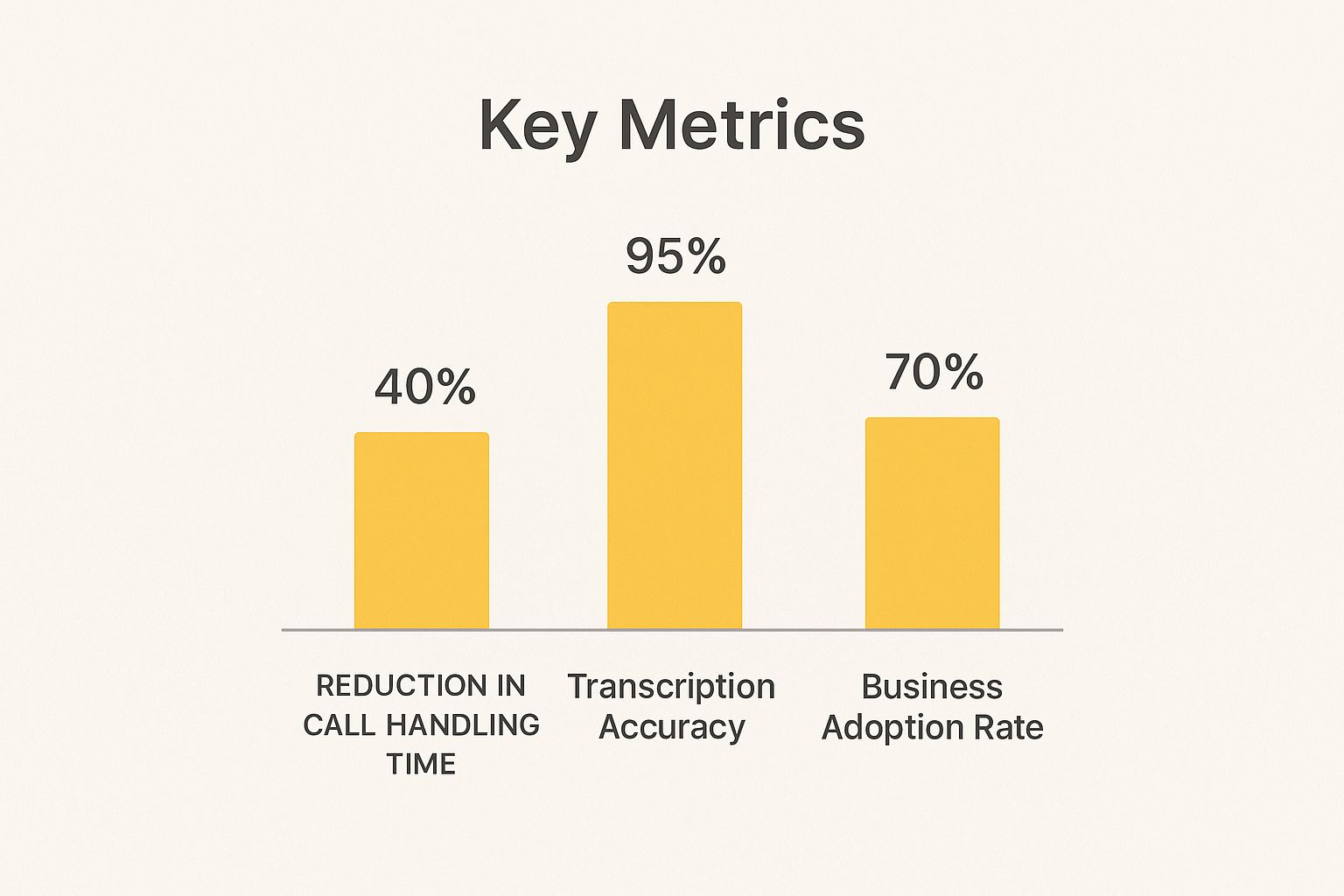An AI voicemail assistant is a smart service that automatically handles your missed calls. It doesn't just record a message; it converts it to text and gives you a quick summary of the important bits. Think of it as a personal receptionist, turning a chaotic voicemail inbox into an organised, easy-to-scan list so you can get back to what truly matters.
What Is an AI Voicemail Assistant?
Are you constantly battling a full voicemail inbox? Picture having a personal receptionist who works 24/7, never takes a break, and instantly organises every call you miss. That's pretty much what an AI voicemail assistant brings to the table. It’s a clever service that intercepts the calls you can't get to, creating a smooth experience for your callers while saving you a massive amount of time.
This isn't your run-of-the-mill voicemail-to-text service. A proper AI voicemail assistant goes much further, using sophisticated tech to grasp the context and urgency of each message.
Here's a simple way to look at it: traditional voicemail is like a pile of unopened mail. You have to manually sift through everything. An AI assistant is like having a personal secretary who opens, reads, and summarises each letter, then hands you only the ones needing your immediate attention.
How It Works
The whole process is built for efficiency. When you miss a call, it’s automatically sent to the AI system, which then gets to work on its main tasks:
- Instant Transcription: The audio message is turned into accurate, readable text. Modern systems are incredibly good at this, even when dealing with different accents or background noise.
- Intelligent Summarisation: Instead of hitting you with a wall of text, the AI picks out the crucial info—like names, contact details, and why they called—and gives you a short, sharp summary.
- Actionable Insights: The system can often figure out the caller's tone or intention (e.g., urgent, just an enquiry, a follow-up), helping you prioritise who to call back first.
This image really drives home how much of an impact these systems have on business productivity.

The numbers speak for themselves. Businesses aren't just jumping on this technology; they're seeing real, measurable improvements in efficiency and accuracy. This trend is especially strong in markets where people are quick to adopt new tech.
To really see the difference, let’s compare the old way of doing things with the new AI-powered approach.
From Voicemail Clutter to AI Clarity
| Task | Traditional Voicemail | AI Voicemail Assistant |
|---|---|---|
| Checking Messages | Listen to each message one by one | Scan text summaries in seconds |
| Finding Key Info | Replay messages to catch names/numbers | Key details are automatically extracted |
| Prioritising Calls | Guess urgency based on tone or message length | Urgency and intent are flagged for you |
| Response Time | Slow, as you need dedicated time to listen | Fast, as you can reply instantly via text |
This side-by-side view makes it clear how much friction an AI assistant removes from your day-to-day communications.
The Australian Advantage
When it comes to adopting AI, Australia is leading the charge, especially with voice-activated tools. With over 38 million AI-related searches, Aussies are the most enthusiastic users of AI platforms per person on the planet. This wide acceptance shows we're more than ready to bring smart tools like an AI voicemail assistant into our daily business routines to get more done. You can dig deeper into Australia's AI habits at Redsearch.
At the end of the day, this technology is designed to give busy professionals back their most precious resource: time. It transforms the headache of managing voicemails into a simple, straightforward process, making sure you stay responsive and on top of your communications.
How AI Is Reinventing Voicemail Technology

So, how does an AI voicemail assistant actually figure out what your callers are saying? It’s not magic, but it’s pretty close. Think of it like having a super-efficient human assistant who listens to a voicemail, types it out perfectly, pulls out the important bits, and even gets a feel for the caller's mood.
At its core, this tech relies on a few key building blocks working together. The AI acts as a brilliant translator, turning messy, jumbled audio into clean, actionable information you can use in a flash.
From Spoken Words to Digital Text
The first and most critical step is speech-to-text transcription. This is where the system takes the raw audio of a voicemail and turns it into written words. It’s far more sophisticated than the basic voice-to-text feature on your phone.
These systems are trained on massive datasets of spoken language, which is how they get so accurate. This training covers:
- Diverse Accents: They learn to understand a huge range of accents, including the many different ones you’ll hear across Australia.
- Speaking Styles: The AI learns to keep up with fast talkers, slow talkers, and everyone in between.
- Background Noise: It can tune out distractions like traffic, music, or worksite chatter to zero in on the speaker's voice.
This process transforms an audio file you’d have to stop and listen to into a block of text you can scan in seconds. This initial conversion is the bedrock for all the other clever features that make an AI voicemail assistant such a powerful tool for your business.
Making Sense of the Message
Once the voicemail is in text form, Natural Language Processing (NLP) steps in. This is where the real "intelligence" happens. NLP is the tech that lets the AI understand the meaning, context, and intent behind the words—not just recognise them.
Think of it this way: speech-to-text is the scribe who writes down everything that’s said. Natural Language Processing is the clever analyst who reads the transcript, figures out what’s important, and prepares a concise brief for the boss.
NLP is what lets an AI assistant perform complex tasks. It can accurately pinpoint key information like names, phone numbers, and specific requests. For example, it can pull out "Call back ASAP about the quote" and flag it as urgent. The system can even perform sentiment analysis to gauge if a caller is happy, frustrated, or neutral, helping you prioritise who to call back first.
Ultimately, by combining crystal-clear transcription with deep language understanding, an AI voicemail assistant doesn’t just record messages—it deciphers them. It turns a chaotic stream of audio into organised, prioritised, and actionable information, ready for you to get on with your day.
Must-Have AI Voicemail Assistant Features

Let's be honest, not all AI voicemail assistants are created equal. While plenty of services can turn your audio messages into text, the ones that truly make a difference do a lot more than just basic transcription. They have smart features that actively manage your calls for you.
Knowing what to look for is the key to choosing a service that genuinely fixes your biggest communication headaches. It’s the difference between just getting a script of your voicemails and getting actionable intelligence that gives you back your time and focus.
Essential Transcription and Summarisation
Everything starts with high-accuracy transcription. The AI has to be sharp enough to convert spoken words into clear, readable text with very few mistakes. This is non-negotiable, especially when dealing with the mix of Aussie accents, industry-specific jargon, or the background noise of a busy worksite. If the transcription is shoddy, every other feature becomes pretty much useless.
But a great service doesn't just hand you a wall of text and call it a day. It uses AI to generate intelligent summaries. Instead of making you read a long, rambling message, the assistant gets straight to the point, pulling out only the most important details.
A powerful summary is like an executive brief for every single call. It tells you who called, their contact details, why they're ringing, and what they need you to do next. You get the whole picture in seconds, without having to read the full transcript.
This is a complete game-changer for busy professionals. Imagine a plumber on a noisy job. They can just glance at their phone and see a summary like, "Caller: Jane Smith. New job enquiry. Leaking pipe at 123 Main Street. Needs urgent call back." There's no need to stop everything to listen to a two-minute message; all the critical info is right there.
Automated Message Categorisation
Another feature you can't do without is automated message categorisation. A smart AI voicemail assistant doesn't just deliver messages—it organises them for you. It intelligently analyses the content and even the tone of each voicemail to sort them into logical piles.
This automatic filtering is your first line of defence against distractions and inbox chaos. The most useful categories you'll see are:
- Urgent: This flags messages that need your attention now, like a time-sensitive client request or an emergency.
- New Lead: It spots potential new business, which is gold for anyone focused on sales, letting you prioritise those callbacks.
- Enquiry: General questions get grouped here, so you can tackle them when you actually have a free moment.
- Spam: It automatically detects and weeds out annoying sales calls and robocalls, keeping your voicemail inbox clean and focused.
Think of a real estate agent who gets a message from a vendor accepting an offer. Their AI assistant can automatically tag that as a high priority, while filtering out the nuisance calls trying to sell them something. This kind of organisation ensures you never miss a golden opportunity just because it was buried in your inbox. To see how all these tools work together, you can check out the full range of OnSilent's advanced features and see what a complete call management solution really looks like.
By making sure your AI voicemail assistant has these must-have features—accurate transcription, intelligent summaries, and automated categorisation—you'll find a tool that slots right into your workflow and quickly becomes an indispensable part of how you do business.
Right, let's get down to brass tacks. Beyond the slick tech, what real-world difference can an AI voicemail assistant actually make to your day? For busy Aussie professionals, the true value isn't in the fancy features themselves, but in how they directly improve your work life. This is where the whole "AI" concept stops being an abstract idea and starts becoming a solid business advantage.
The first thing you'll notice is how much time you get back. Forget blocking out chunks of your day to painstakingly listen to every single voicemail. Now, you can just scan clean, accurate summaries in a few seconds. That means you can sort through new business enquiries between meetings, check client updates while you're grabbing a coffee, or clear out your messages at the end of the day in a tiny fraction of the time it used to take.
The core promise of an AI voicemail assistant is simple: it gets rid of the hassle of managing missed calls. By turning audio into text you can actually use, it gives you back control over your communication and, more importantly, your schedule.
This newfound efficiency naturally leads to faster response times, which is a massive deal for keeping up a strong professional reputation. When a hot lead calls, they're identified and prioritised instantly. This lets you follow up while they're still keen, meaning you'll never again let a golden opportunity slip through the cracks just because it was buried under a pile of less important messages.
Boosting Your Business and Work-Life Balance
An AI voicemail assistant does more than just tidy up your messages; it genuinely boosts how efficiently you operate. If you're a small business owner, it's like having a virtual receptionist on duty, making sure every customer feels heard and every message is dealt with promptly. This doesn't just make for happier customers, it also cements your image as a responsive and reliable business.
And it seems Aussies are ready for it. With 49% of Australians having used generative AI in the last year and 52% believing it will benefit people like them, the timing is perfect. This growing comfort level shows the local market is ready to embrace smart tools like an AI voicemail assistant. You can discover more insights about AI adoption in Australia to see the full picture.
But this isn't just about business results; it's also about getting your work-life balance back in check. By taking care of one of the most annoying and persistent daily tasks, it frees up a lot of mental space. You can finally finish your workday knowing all your communications are sorted, without that nagging feeling of a full voicemail inbox waiting for you. For a deeper dive into how this works, check out our guide on the benefits of a voicemail to text service. It means you can properly switch off, knowing you can quickly catch up on anything important when you're back on the clock.
Alright, let's give this a human touch. Here’s the rewritten section, crafted to sound like it's coming from an experienced professional who knows their stuff, not a machine.
Putting AI to Work with OnSilent
Theory is great, but seeing an AI voicemail assistant in action is where the penny really drops. OnSilent is a perfect example of this technology put to good use, built specifically for busy Australian professionals who need a practical solution, not just another bit of confusing software. It’s designed to finally deliver on that promise of effortless communication, taking abstract AI concepts and turning them into a genuinely useful, real-world tool.
Let’s walk through what this actually looks like. Imagine you're a real estate agent, right in the middle of a property inspection. Your phone buzzes with an unknown number. You can't possibly answer, so the call is instantly and seamlessly picked up by the OnSilent AI. There’s no clunky handover or an awkward, robotic greeting—just a smooth, professional interaction for your caller.
Moments later, you get a notification. But instead of a vague alert about a new voicemail, you get a crisp, perfectly transcribed message and summary sent straight to your preferred app. You can see at a glance if it's an urgent enquiry from a new buyer or just a routine follow-up. All without ever having to stop what you're doing to listen to a single second of audio.
Fine-Tuned for Australian Professionals
Let's be honest, one of the biggest hurdles for voice tech in Australia has always been understanding our unique accents and slang. A generic AI assistant often gets it wrong, leading to some seriously frustrating and inaccurate transcriptions. OnSilent tackles this head-on by using an AI model that’s been specifically trained on a massive range of Australian accents, from the inner city to the regional towns.
This focus on local accuracy is what shifts the service from a bit of a novelty into a reliable business tool. When you know every word is captured correctly, you can trust the information and act on it with complete confidence.
It’s this dedication to a smooth user experience that makes it so effective. We're not just talking about converting voice to text; we're talking about delivering clear, actionable information that slots right into your daily workflow, saving you time and making sure you never miss an opportunity.
The Growing Demand for Smart Communication
The move towards tools like OnSilent isn't happening in a vacuum—it reflects a much larger trend in the Aussie business world. The local conversational AI market, which includes the ai voicemail assistant sector, is seeing some explosive growth. Currently valued at around USD 380.8 million, it’s projected to absolutely skyrocket to over USD 5,754.9 million. This incredible expansion is being fuelled by businesses of all sizes eagerly adopting digital solutions to improve everything from customer service to sales. You can learn more about the rapid growth of conversational AI in Australia.
This just goes to show that professionals are no longer just interested in AI—they're actively hunting for practical applications that solve real-world problems. OnSilent meets this demand directly, offering a purpose-built solution that turns the daily headache of voicemail into a genuine competitive advantage.
Common Questions About AI Voicemail

Jumping into new technology always comes with a few questions. And when it comes to handing your calls over to an AI, it’s only natural to want to understand how it all works – especially the practical stuff like security and setup.
This section tackles the most common queries we hear from professionals about using an AI voicemail assistant. We want to give you direct, clear answers that build confidence and show you just how practical this technology really is for your business.
How Secure Is My Data With an AI Voicemail Assistant?
This is usually the first and most important question on everyone's mind. We get it. Your privacy is paramount, and any reputable provider will treat it that way. Leading services like OnSilent use end-to-end encryption for all communications.
Put simply, this means your voicemail audio and its text transcriptions are shielded from any unauthorised eyes. Your confidential client info and sensitive business details are treated with the highest level of security, just as you'd demand from any professional business tool.
As a rule of thumb, always check that a service is upfront about its privacy policy and complies with Australian data protection laws. It’s the best way to ensure your data, and your clients' data, is in safe hands.
Will It Work With My Existing Phone Number?
Yes, absolutely. A good AI voicemail assistant is built to slot in perfectly with your current mobile number. There’s no need to change numbers, reprint business cards, or send out a mass text telling everyone you've got a new contact.
The setup process is surprisingly simple and non-disruptive. It uses a standard mobile feature called 'conditional call forwarding', which you can switch on in your phone's settings. It just means that when you're busy, on another call, or simply don't answer, the call gets automatically redirected to the AI service to be handled.
Your callers won't notice a thing. The entire process happens seamlessly in the background, making it a dead-simple and practical upgrade to your current setup.
Can the AI Understand Different Australian Accents?
This is a critical point for any voice technology being used down under. The best AI models are specifically trained on incredibly diverse datasets that include a massive range of Aussie accents, dialects, and everyday slang from across the country.
This is where advanced Natural Language Processing (NLP) comes in. It ensures the service can maintain a high level of transcription accuracy, whether your caller is from a major city or a regional town. This commitment to understanding local speech patterns is what makes the tool genuinely reliable for day-to-day business.
Is It Difficult to Set Up?
Not at all. The entire setup process is designed to be user-friendly and usually takes just a few minutes. You don't need to be a tech whiz to get it done. Typically, the steps look like this:
- Sign Up: Create an account with your chosen service.
- Get the App: Download the service’s app onto your smartphone.
- Activate Forwarding: Follow the simple, on-screen instructions to set up conditional call forwarding on your phone.
Once that’s sorted, you can start enjoying organised, transcribed voicemails almost immediately. If you have more specific questions, you can always find detailed answers by exploring our complete FAQ section.
Ready to stop worrying about missed calls and start reclaiming your time? OnSilent provides a powerful, secure, and easy-to-use AI voicemail assistant designed for busy Australian professionals. Start your free trial today at onsilent.com and experience the difference.

